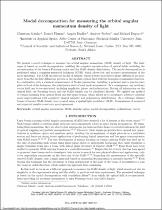JavaScript is disabled for your browser. Some features of this site may not work without it.
- ResearchSpace
- →
- Research Publications/Outputs
- →
- Conference Publications
- →
- View Item
| dc.contributor.author |
Schulze, C

|
|
| dc.contributor.author |
Flamm, D

|
|
| dc.contributor.author |
Dudley, Angela L

|
|
| dc.contributor.author |
Forbes, A

|
|
| dc.contributor.author |
Duparr'e, M

|
|
| dc.date.accessioned | 2013-07-02T12:28:48Z | |
| dc.date.available | 2013-07-02T12:28:48Z | |
| dc.date.issued | 2013-02 | |
| dc.identifier.citation | Christian Schulze ; Daniel Flamm ; Angela Dudley ; Andrew Forbes ; Michael Duparré; Modal decomposition for measuring the orbital angular momentum density of light . Proc. SPIE 8637, Complex Light and Optical Forces VII, 863719 (March 5, 2013) | en_US |
| dc.identifier.uri | http://proceedings.spiedigitallibrary.org/proceeding.aspx?articleid=1661728 | |
| dc.identifier.uri | http://hdl.handle.net/10204/6842 | |
| dc.description | Proceedings of SPIE, San Francisco (USA), 3-6 February 2013. Published in SPIE Digital library | en_US |
| dc.description.abstract | We present a novel technique to measure the orbital angular momentum (OAM) density of light. The technique is based on modal decomposition, enabling the complete reconstruction of optical fields, including the reconstruction of the beams Poynting vector and the OAM density distribution. The modal decomposition is performed using a computer-generated hologram (CGH), which allows fast and accurate measurement of the mode spectrum. The CGH encodes the modes of interest, whose powers and relative phase differences are measured from the far-field diffraction pattern of the illuminating optical field with the hologram transmission function. In combination with a classical measurement of Stokes parameters, including a polarizer and a quarter-wave plate in front of the hologram, the polarization state of each mode is measured. As a consequence, any arbitrary vector field can be reconstructed, including amplitude, phase, and polarization. Having all information on the optical field, the Poynting vector and the OAM density can be calculated directly. We applied our method to beams emerging from optical fibers, which allows us to investigate arbitrary coherent superposition of fiber modes with complexly shaped intensity and polarization distributions. The excitation of certain mode mixtures is done by appropriate input coupling and using diffractive phase masks to shape the input beam and hence enhance the excitation efficiency of distinct modes. The accuracy of the achieved results is verified by comparing the reconstructed with the directly measured beam intensity, revealing excellent agreement. | en_US |
| dc.language.iso | en | en_US |
| dc.publisher | SPIE Digital library | en_US |
| dc.relation.ispartofseries | Workflow;10598 | |
| dc.subject | Orbital angular momentum | en_US |
| dc.subject | Modal decomposition | en_US |
| dc.subject | Optical fields | en_US |
| dc.subject | Poynting vector | en_US |
| dc.subject | Singular optics | en_US |
| dc.subject | Polarization | en_US |
| dc.subject | Vortex | en_US |
| dc.title | Modal decomposition for measuring the orbital angular momentum density of light | en_US |
| dc.type | Conference Presentation | en_US |
| dc.identifier.apacitation | Schulze, C., Flamm, D., Dudley, A. L., Forbes, A., & Duparr'e, M. (2013). Modal decomposition for measuring the orbital angular momentum density of light. SPIE Digital library. http://hdl.handle.net/10204/6842 | en_ZA |
| dc.identifier.chicagocitation | Schulze, C, D Flamm, Angela L Dudley, A Forbes, and M Duparr'e. "Modal decomposition for measuring the orbital angular momentum density of light." (2013): http://hdl.handle.net/10204/6842 | en_ZA |
| dc.identifier.vancouvercitation | Schulze C, Flamm D, Dudley AL, Forbes A, Duparr'e M, Modal decomposition for measuring the orbital angular momentum density of light; SPIE Digital library; 2013. http://hdl.handle.net/10204/6842 . | en_ZA |
| dc.identifier.ris | TY - Conference Presentation AU - Schulze, C AU - Flamm, D AU - Dudley, Angela L AU - Forbes, A AU - Duparr'e, M AB - We present a novel technique to measure the orbital angular momentum (OAM) density of light. The technique is based on modal decomposition, enabling the complete reconstruction of optical fields, including the reconstruction of the beams Poynting vector and the OAM density distribution. The modal decomposition is performed using a computer-generated hologram (CGH), which allows fast and accurate measurement of the mode spectrum. The CGH encodes the modes of interest, whose powers and relative phase differences are measured from the far-field diffraction pattern of the illuminating optical field with the hologram transmission function. In combination with a classical measurement of Stokes parameters, including a polarizer and a quarter-wave plate in front of the hologram, the polarization state of each mode is measured. As a consequence, any arbitrary vector field can be reconstructed, including amplitude, phase, and polarization. Having all information on the optical field, the Poynting vector and the OAM density can be calculated directly. We applied our method to beams emerging from optical fibers, which allows us to investigate arbitrary coherent superposition of fiber modes with complexly shaped intensity and polarization distributions. The excitation of certain mode mixtures is done by appropriate input coupling and using diffractive phase masks to shape the input beam and hence enhance the excitation efficiency of distinct modes. The accuracy of the achieved results is verified by comparing the reconstructed with the directly measured beam intensity, revealing excellent agreement. DA - 2013-02 DB - ResearchSpace DP - CSIR KW - Orbital angular momentum KW - Modal decomposition KW - Optical fields KW - Poynting vector KW - Singular optics KW - Polarization KW - Vortex LK - https://researchspace.csir.co.za PY - 2013 T1 - Modal decomposition for measuring the orbital angular momentum density of light TI - Modal decomposition for measuring the orbital angular momentum density of light UR - http://hdl.handle.net/10204/6842 ER - | en_ZA |






